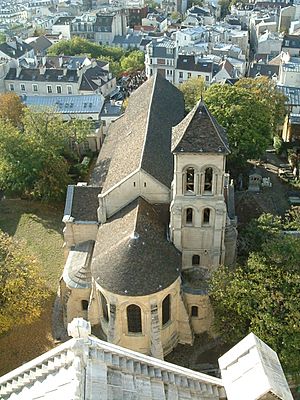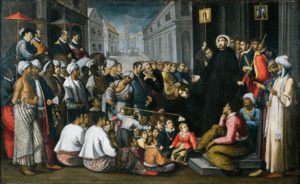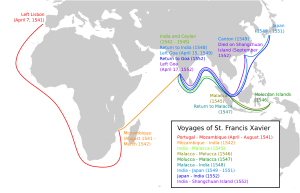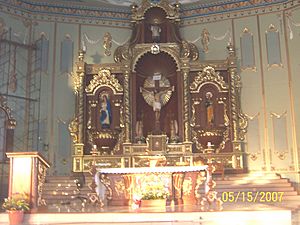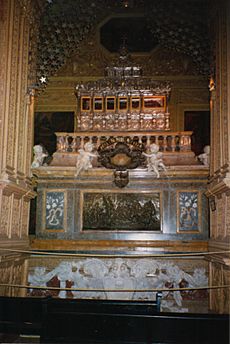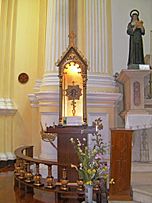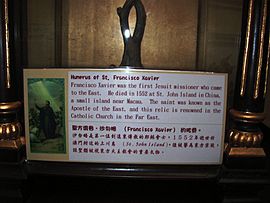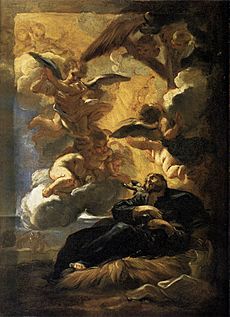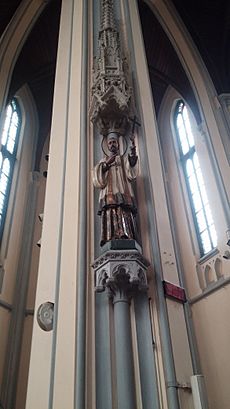Francis Xavier facts for kids
Quick facts for kids SaintFrancis Xavier SJ |
|
|---|---|
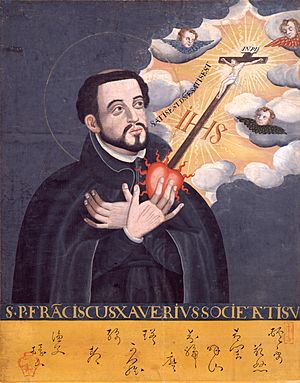
A painting of Saint Francis Xavier, held in the Kobe City Museum, Japan
|
|
| Born | Francisco de Jasso y Azpilicueta 7 April 1506 Javier, Kingdom of Navarre |
| Died | 3 December 1552 (aged 46) Shangchuan Island, Chuanshan Archipelago, Xinning, China |
| Venerated in | |
| Beatified | 25 October 1619, Rome, Papal States by Pope Paul V |
| Canonized | 12 March 1622, Rome, Papal States by Pope Gregory XV |
| Feast | 3 December |
| Attributes | Cassock, surplice, stole, ferraiolo, and a crucifix |
| Patronage | African missions; Kottar, India; Agartala, India; Ahmedabad, India; Alexandria, Louisiana; Apostleship of Prayer; Australia; Bengaluru, India; Bombay, India; Borneo; Cape Town, South Africa; China; Dinajpur, Bangladesh; Far East; Fathers of the Precious Blood; foreign missions; Freising, Germany; Goa, India; Fiji; Green Bay, Wisconsin; India; Indianapolis, Indiana; Japan; Key West, Florida; Sophia University, Tokyo, Japan; University of Saint Francis Xavier, Sucre, Bolivia; Joliet, Illinois; Kabankalan, Philippines; Kollam, India; Nasugbu, Batangas, Philippines; Abuyog, Leyte, Philippines; Alegria, Cebu, Philippines; Hong Kong; Macau; Diocese of Malindi, Kenya; missionaries; Missioners of the Precious Blood; Navarre, Spain; navigators; New Zealand; parish missions; plague epidemics; Propagation of the Faith; India, Zagreb, Croatia; Indonesia; Malacca, Malaysia; Brunei; Pakistan; Philippines; Singapore; Sri Lanka |
| Styles of Francis Xavier |
|
|---|---|
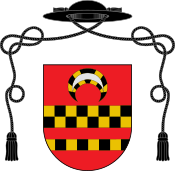 |
|
| Reference style | The Reverend Father |
| Spoken style | Father |
| Posthumous style | Saint |
Francis Xavier (born Francisco de Jasso y Azpilicueta; 7 April 1506 – 3 December 1552) was a Catholic missionary and saint. He was one of the first members of the Society of Jesus, also known as the Jesuits.
Born in Javier, a place in the Kingdom of Navarre (now part of Spain), he was a friend of Ignatius of Loyola. They were among the first seven Jesuits who made special promises of poverty and chastity in Paris in 1534. Francis Xavier traveled widely in Asia, especially in the Portuguese Empire's eastern territories. He played a big role in spreading Christianity, particularly in early modern India. He also visited Borneo and the Maluku Islands. He hoped to go to China, but he died on Shangchuan Island before he could reach the mainland.
Francis Xavier was declared a saint by Pope Gregory XV on 12 March 1622. He is known as the "Apostle of the Indies" and the "Apostle of the Far East". Many consider him one of the most important missionaries since Paul the Apostle. In 1927, Pope Pius XI named him a co-patron of all foreign missions. His feast day is celebrated on 3 December.
Contents
Early Life and Education
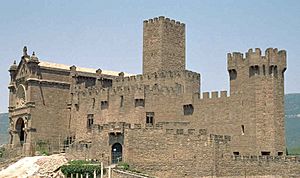
Francis Xavier was born on 7 April 1506, in the Castle of Xavier. His family was important and noble in the Kingdom of Navarre. He was the youngest son of Don Juan de Jasso y Atondo, who was a high-ranking official. His mother was Doña María de Azpilcueta y Aznárez.
In 1512, the King of Aragon invaded Navarre. This led to a long war. When Francis was nine, his father died. In 1516, Francis's brothers tried to fight off the Spanish invaders but failed. The Spanish governor took their family lands and damaged their castle. Only the family home inside the castle was left.
In 1525, Francis went to study in Paris at the Collège Sainte-Barbe. He stayed there for eleven years. He was known for being good at sports, especially high-jumping.
In 1529, Francis shared his room with his friend Pierre Favre and a new student, Ignatius of Loyola. Ignatius was older and tried to convince Francis to become a priest. At first, Francis was not interested. He wanted to achieve worldly success. But Ignatius slowly helped Francis change his mind.
In 1530, Francis earned his Master of Arts degree. After that, he taught philosophy at Beauvais College in Paris.
Missionary Journeys
On 15 August 1534, Francis and six other students met in a crypt under a church in Paris. They included Ignatius of Loyola, Peter Faber, and Simão Rodrigues. They made special promises to live simply and obey the Pope. They also promised to go to the Holy Land to spread their faith. Francis began studying theology in 1534 and became a priest on 24 June 1537.
In 1539, Ignatius created a plan for a new religious group called the Society of Jesus (the Jesuits). Pope Paul III approved this plan in 1540.
The King of Portugal, John III, asked for Jesuit missionaries to go to India. He wanted them to help strengthen Christian values among the Portuguese settlers there. Ignatius chose Francis Xavier to go. This is how Francis Xavier became the first Jesuit missionary.
Francis left Rome on 15 March 1540. He carried a prayer book and a book on how to live well. He arrived in Lisbon, Portugal, in June 1540. The King and Queen met with him and Rodrigues.
Francis Xavier spent much of his life on missions in Asia. He focused on four main areas: Malacca, Amboina and Ternate, Japan, and areas near China. He believed these places were connected and needed to be reached together.
Goa and India
Francis Xavier left Lisbon on his 35th birthday, 7 April 1541. He traveled with two other Jesuits and the new viceroy, Martim Afonso de Sousa. He arrived in Goa, the capital of Portuguese India, on 6 May 1542.
His main job was to help the Portuguese settlers in Goa. Many of them had lost their Christian values. Francis spent his first five months preaching and helping the sick in hospitals. He also rang a bell in the streets to call children and servants for religious lessons. He was asked to lead Saint Paul's College, a school for priests. This college became the first Jesuit headquarters in Asia.
Spreading the Faith

Francis learned about the Paravar people along the Pearl Fishery Coast in southern India. Many of them had been baptized years before but knew little about Christianity. In October 1542, he sailed to Cape Comorin. He taught those who were already baptized and preached to others. He spent almost three years preaching in southern India and Ceylon (now Sri Lanka). He converted many people and built nearly 40 churches along the coast.
During this time, he visited the tomb of Thomas the Apostle in Mylapore. In 1545, he decided to travel eastward to Makassar in Celebes (Indonesia).
Francis Xavier was the first Jesuit in India. He found it hard to convert many people at first. Later missionaries, like Matteo Ricci, tried to convert important people first. Francis had mostly worked with common people. However, in Japan, Francis changed his approach and tried to meet with the Emperor.
Southeast Asia
In spring 1545, Xavier went to Portuguese Malacca. He worked there for several months. Around January 1546, he left Malacca for the Maluku Islands, where the Portuguese had settlements. He preached there for a year and a half. He visited Ambon Island, Ternate, and other islands. In 1547, he returned to Malacca.
Japan
In Malacca in December 1547, Francis Xavier met a Japanese man named Anjirō. Anjirō had heard about Francis and traveled from Japan to meet him. Anjirō told Francis about Japan's customs and culture. Anjirō became the first Japanese Christian and helped Xavier as an interpreter.
In January 1548, Francis returned to Goa. He left Goa again on 15 April 1549, stopping in Malacca and visiting Canton. He was with Anjirō and other Jesuits. He brought gifts for the "King of Japan" because he planned to introduce himself as a special messenger from the Pope.
Francis Xavier arrived in Japan on 27 July 1549. He landed at Kagoshima on 15 August. The local ruler, Shimazu Takahisa, welcomed him. However, the ruler later made it illegal to convert to Christianity.
Francis was the first Jesuit missionary in Japan. He used paintings of the Madonna and Child to teach about Christianity. There was a big language barrier, as Japanese was very different from other languages he knew. He struggled to learn it. He stayed with Anjirō's family until October 1550. He then lived in Yamaguchi. He tried to meet the Emperor in Kyoto but failed. He returned to Yamaguchi in March 1551, where he was allowed to preach.
Francis learned that being poor did not impress people in Japan as it did in Europe. So, he changed his approach. He dressed in fine clothes and had many attendants. He presented himself as a representative of Portugal to local rulers, offering gifts.
The Japanese people were not easy to convert. Many were already Buddhist or Shinto. Francis tried to explain Christian ideas. He felt that the Japanese were good people, similar to Europeans, and could become Christians.
Xavier was first welcomed by Shingon monks because he used the word Dainichi for the Christian God. He tried to connect with local traditions. But as he learned more, he changed to Deusu (from Latin Deus). The monks then realized he was teaching a different religion and became less friendly.
After more than two years in Japan, Francis Xavier saw that Jesuit missions were established. He decided to return to India.
China
On his way back to India from Japan, a storm forced Francis to stop near Guangzhou, China. There, he met Diogo Pereira, a rich merchant. Pereira showed him a letter from Portuguese prisoners in Guangzhou. They asked for a Portuguese ambassador to speak to the Chinese Emperor for them. Francis planned to go to China as a special messenger from the Pope.
In late August 1552, Francis's ship reached Shangchuan Island, near the coast of China. He was with a Jesuit student and two servants. Around mid-November, he sent a letter saying someone would take him to the mainland for a lot of money. He died from a fever on Shangchuan Island on 3 December 1552. He was waiting for a boat to take him to mainland China.
Burials and Relics
Francis Xavier was first buried on a beach on Shangchuan Island. His body was moved in February 1553 to St. Paul's Church in Malacca. An open grave there marks his temporary burial spot. On 11 December 1553, his body was shipped to Goa.
His body is now in the Basilica of Bom Jesus in Goa. It is kept in a glass container inside a silver casket. This casket was made by Goan silversmiths between 1636 and 1637. It shows 32 silver pictures of different events from Xavier's life.
- Francis is tied up, but the ropes break by a miracle.
- He kisses a patient's ulcer in a hospital.
- He is visited by Jerom while sick.
- He has a vision about his future work.
- He saves a secretary while crossing the Alps.
- He heals a sick man.
- He baptizes people in Travancore.
- He brings a boy back to life who died in a well.
- He cures a man with sores.
- He drives away the Badagas people.
- He brings three people back to life.
- He finds money in his empty pockets for a Portuguese man.
- He performs a miraculous cure.
- A crab brings back his crucifix that fell into the sea.
- He preaches on the island of Moro.
- He preaches at sea and announces victory.
- He converts a Portuguese soldier.
- He helps the dying Vicar of Malacca.
- Francis kneels with a child on his shoulders, whom he heals.
- He walks from Amanguchi to Macao.
- He cures a mute and paralyzed man.
- He cures a deaf Japanese person.
- He prays during a storm on a ship.
- He baptizes three kings in Cochin.
- He cures a religious person.
- He sweetens seawater during a voyage when there is no fresh water.
- Francis's final moments at Sancian.
- He is seen by a lady after his death, as he promised.
- His body is shown for people to see.
- Francis floats in the air while giving communion.
- His body is placed in a special place with candles.
His right forearm, which he used to bless and baptize people, was removed in 1614. It is now displayed in a silver container in the main Jesuit church in Rome, Il Gesù.
Another bone from his arm was brought to Macau. It was meant for Japan, but due to religious persecution, it stayed in Macau. In 2017-2018, his right forearm traveled across Canada for people to see and honor.
Veneration and Legacy
Becoming a Saint
Francis Xavier was declared "blessed" by Pope Paul V on 25 October 1619. He was made a saint by Pope Gregory XV on 12 March 1622. This happened at the same time as Ignatius of Loyola. Pope Pius XI later called him the "Patron of Catholic Missions." His feast day is celebrated on 3 December.
Pilgrimage Sites

Many people visit places connected to Saint Francis Xavier.
- In Goa, India, his relics are kept in a silver casket in the Bom Jesus Basilica. They are usually shown to the public every ten years. The last display was from November 2014 to January 2015.
- Other important places include his birthplace, the Castle of Xavier in Navarra, Spain. Also, the Church of the Gesù in Rome, Malacca (where he was buried for two years), and Shangchuan Island (where he died).
- In Magdalena de Kino, Mexico, there is a statue of San Francisco Xavier. Many people visit it. The Mission San Xavier del Bac in Arizona, USA, is also a pilgrimage site.
Novena of Grace
The Novena of Grace is a special prayer to Francis Xavier. It is often prayed for nine days before 3 December, or from 4 March to 12 March. This prayer started with a Jesuit missionary named Marcello Mastrilli. He was badly hurt and saw Xavier in a vision. After recovering, Mastrilli traveled to Japan.
Impact and Influence
Francis Xavier is famous for his missionary work. He is believed to have converted more people than anyone since Paul the Apostle. Pope Benedict XVI said that Francis Xavier and Ignatius of Loyola shared a "passion to give to God... a glory always greater."
Xavier's work helped shape Jesuit missionary methods. His success encouraged many Europeans to join the Jesuit order and become missionaries. His efforts greatly influenced religious practices in India and the Malay Archipelago (Indonesia, Malaysia, Timor). Even today, India has many Jesuit missions and schools.
He also worked to spread Christianity in China and Japan. However, later persecutions in Japan forced Christians to practice their faith secretly. Similarly, Chinese Christians also had to go underground.
A small chapel was built in 1869 over Xavier's death-place on Shangchuan Island. It has been restored several times, most recently in 2006.
Francis Xavier is the patron saint of his home region, Navarre, Spain. His feast day, 3 December, is a public holiday there. People celebrate with Masses and cultural events. Since the 1940s, many Catholics make an annual pilgrimage to Xavier's family castle in Javier.
Names and Dedications
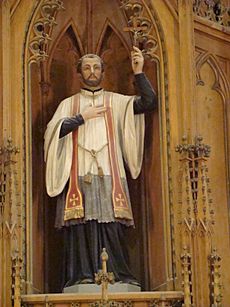
Because he is an important saint, "Francisco Javier" or "Javier" are common male names in Spain and Hispanic countries. The spelling "Xavier" is also popular in the Basque Country, Portugal, and other places. In India, "Xavier" is a common name among Christians, especially in Goa. In Indonesia, "Fransiskus Xaverius" is often used.
Many churches around the world are named after Francis Xavier. These often include churches founded by Jesuits. Examples in the United States are the St. Francis Xavier Shrine and the Basilica of St. Francis Xavier. The Xaverian Brothers is an American teaching order named after him. The Mission San Xavier del Bac in Arizona is famous for its Spanish Colonial architecture.
In Art and Music
- Peter Paul Rubens (1577-1640) painted St Francis Xavier Raising the Dead. This painting shows one of Francis's many miracles.
- The Charles Bridge in Prague, Czech Republic, has a statue of Francis Xavier.
- A statue of Francis Xavier stands in front of Oita Station in Japan.
- The Padrão dos Descobrimentos monument in Lisbon, Portugal, features an image of Francis Xavier.
- Composer Marc-Antoine Charpentier wrote music in honor of Saint Xavier.
Missionary Methods
Modern experts believe Francis Xavier converted about 30,000 people to Christianity. Some of his methods have been discussed. For example, he encouraged converts to take Portuguese names and wear Western clothes. However, he also believed missionaries should learn the local languages and customs. Unlike some later missionaries, Xavier supported having local people become priests.
Even though his work in Japan seemed to be lost due to persecution, Protestant missionaries found about 100,000 Christians still practicing their faith in the Nagasaki area three centuries later. Francis Xavier's work brought lasting change to eastern Indonesia. He is known as the "Apostle of the Indies." By the 1590s, there were 50,000 to 60,000 Roman Catholics in the Maluku Islands.
Role in the Goa Inquisition
In 1546, Francis Xavier wrote a letter to the Portuguese King, John III. In this letter, he suggested setting up the Goa Inquisition. He asked the king to be strict with the Portuguese governor in India to help spread the faith. He also asked the king to protect new converts from harassment. Francis Xavier died in 1552 and never saw the Goa Inquisition begin.
See also
 In Spanish: Francisco Javier para niños
In Spanish: Francisco Javier para niños
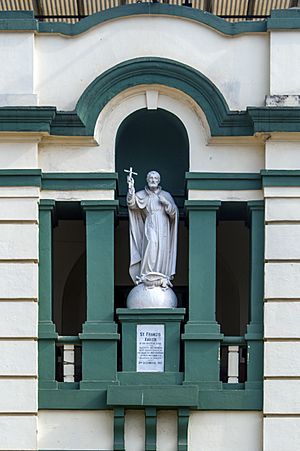
- Catholicism in China
- Catholicism in Japan
- Catholicism in India
- Catholicism in Indonesia
- Christianity in China
- Christianity in Japan
- Christianity in India
- Christianity in Indonesia
- Jesuit China missions
- List of Westerners who visited Japan before 1868
- Mission San Xavier del Bac — San Xavier District, Tohono O'odham Nation, Arizona
- Xaverian Brothers — religious order in America
- Xavier High School (New York City)
- Xavier School — San Juan City, Philippines
- Xavier University – Ateneo de Cagayan, Cagayan de Oro City, Philippines
- St. Francis Xavier University - Antigonish, Nova Scotia, Canada
- St. Francis Xavier Catholic Secondary School - Milton, Ontario, Canada
- St. Francis Xavier Catholic Secondary School - Mississauga, Ontario, Canada
- St. Xavier's Institution - Georgetown, Penang, Malaysia
- Saint Francis Xavier, patron saint archive
- Xavier College - Melbourne, Victoria, Australia
- St. Xavier's College, Kolkata
- St. Xavier's School, Kolkata


